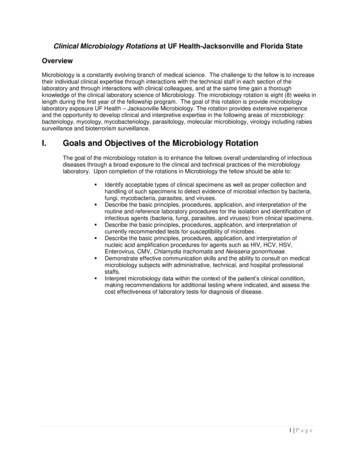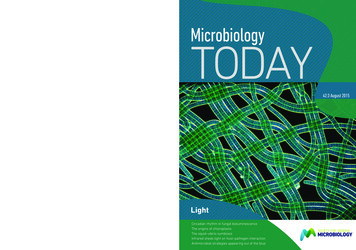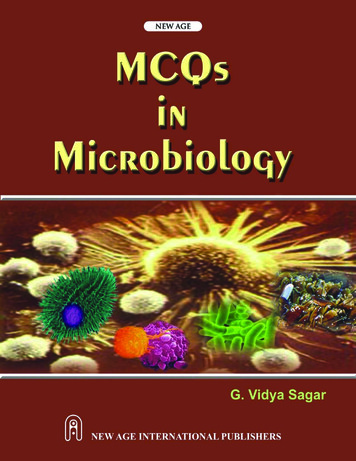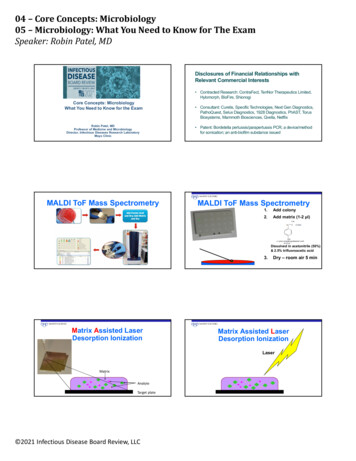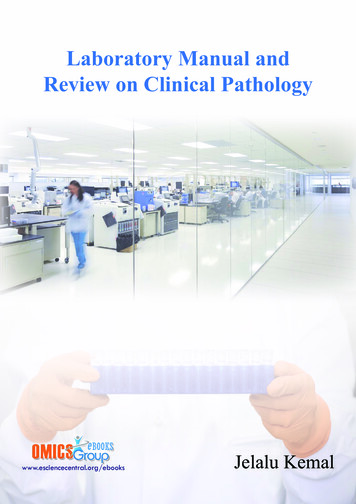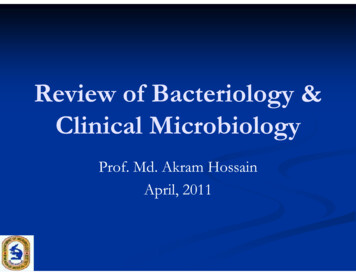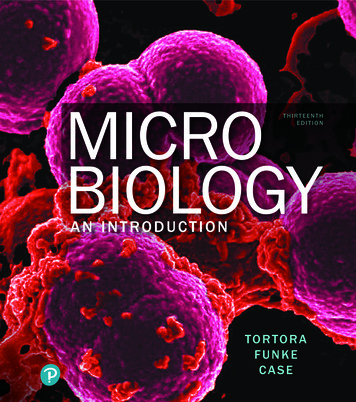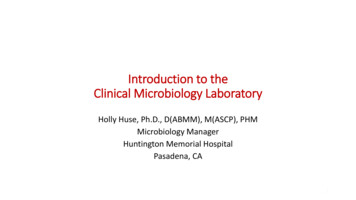
Transcription
Introduction to theClinical Microbiology LaboratoryHolly Huse, Ph.D., D(ABMM), M(ASCP), PHMMicrobiology ManagerHuntington Memorial HospitalPasadena, CA1
At the conclusion of this program, you will be able to: Describe the primary role of a clinical microbiology laboratory with a focus onbacteriology. Explain how improperly collected specimens can contribute to misleadingresults. List examples where bacteria reported may NOT be contributing to an infection. Discuss tests used to determine if a bacterium is susceptible or resistant to anantimicrobial agent. Describe a cumulative antibiogram and how this report can be used to guideempiric therapy and monitor % of bacteria susceptible (%S) to specificantimicrobial agents.2
Scenario: Sick patient in the hospitalPhysicianInfection Prevention Physician sends a specimen to theclinical microbiology lab What does he/she want to know? Does the specimen containpathogens? What type? How many? What antimicrobials can I use totreat this patient? Reviews microbiology laboratoryreports What does he/she want to know? Could the pathogens isolated havebeen acquired while the patient wasin this facility? What can be done to prevent thespread of the pathogens?3
What is Clinical Microbiology? Function of the clinical microbiology laboratory: Clinical: diagnosis and management of infections Epidemiological: understand infectious microbes in patients andpopulations, and to find sources and routes of transmission necessary forprevention efforts General rules in clinical microbiology: #1: Positive cultures do not make an infection #2: No lab test is 100% accurate4
Who are clinical microbiologists? Bachelor’s degree that includes 2 years ofspecialized training in clinical laboratorysciences CLS: clinical laboratory scientist MLT: medical laboratory technician Ph.D.: perform research and developmentwww.wikipedia.com
Where are Clinical Microbiologists? HuntingtonMemorial Hospital Pasadena, CA Tertiary care, nonacademic 619 beds 6 outpatient clinics 1 urgent care
What is Clinical Microbiology? Function of the clinical microbiology laboratory: Clinical: diagnosis and management of infections Epidemiological: understand infectious microbes in patients andpopulations, and to find sources and routes of transmission necessary forprevention efforts General rules in clinical microbiology: #1: Positive cultures do not make an infection #2: No lab test is 100% accurate7
Specimen collection Proper specimen collection is one of themost important factors in diagnosinginfection Follow instructions for collecting andtransporting specimens for microbiologytests The best specimens are tissue,aspirate, pus, body fluid Swabs are low yield and prone tocontaminationE-swab8 transportViral8
Challenge: MicrobiomeMouth Microorganisms that live on andIntestinal tractwithin our bodies AKA “normal flora”Vagina Trillions of cells! 1000s of species! Both beneficial and potentiallyharmful Challenge: differentiating normal florafrom pathogensSkin
Specimen processingBiosafety Cabinet (BSC)Direct Gram stainCulture
Gram stain Han Christian Gram: 1884 Method of classifying bacteria into 2large groups: Gram positive ( ) andGram negative (-) Differentiates bacteria by thechemical and physical properties oftheir cell walls Helpful in guiding initial empirictherapy Reported to physicians ASAP11Gram positive:thick cell wallGram negative:11 thin cell wall
Perform Direct Gram stain for bacteriaReport results within a few hoursQuick insight into possible causes of an infection12
Gram stain reactions for select bacteriaGram positiveStaphylococcusGram negativeStreptococcusE. coliKlebsiellaPseudomonasCocci spheresRodsCocci in clustersAlso detects markers ofinfection White Blood CellsCocci in chainsCocciNeisseria
Direct Gram stain of pus from a woundGram-positive cocci inclustersWhite blood cellsStaphylococci14
Direct Gram stain of urethral dischargeGram-negativecocci within whiteblood cellsGonorrhoeae15
Culturing bacteriaIncubator:human body temperatureShould I identify these bacteria andperform antimicrobial susceptibilitytests?
Criteria for identification Should I identify these bacteria andperform antimicrobial susceptibilitytests? Body site Pure versus mixed culture Pathogen versus normal flora
Methods Used to Identify BacteriaTraditional methods: Gram stain and microscopic exam Growth rate and colony appearance on various types of agarmedia Reactivity with various chemicals/reagentsModern methods: DNA/RNA content of microorganisms Protein profile (MALDI-TOF MS) of microorganisms18
Case 1 85 year old male He has been sick for 3 days Getting progressively worse Shortness of breath Fever, chills, sweats, productive cough Temperature of 102 F Pneumonia Sputum cultures Blood cultures10 ml sputum in Luken’s trapAvoid collecting salivaBlood culture
Common Lower Respiratory Tract Pathogens Community-acquired pneumonia (CAP) Streptococcus pneumoniaeHaemophilus influenzaeMoraxella catarrhalis“Atypicals” – Mycoplasma pneumoniae, Chlamydophila pneumoniae, andLegionella pneumophila Often more difficult to recover / identify Hospital-acquired pneumonia (HAP): Most often ICU or ventilatorassociated Klebsiella pneumoniae Pseudomonas aeruginosa Either CAP or HAP Staphylococcus aureus MRSA or MSSA20
Assessing Sputum Specimen Quality If saliva instead of sputum is collected,we may not recover the “truepathogens” Prepare a direct Gram stain Count the number of squamousepithelial cells (SEC)# SEC/low power fieldInterpretation 10No significant oralcontamination 10Indicates poorlycollected specimen21
Direct Gram Stain Results Report: Many WBCs Many Gram-positive cocciin clusters Moderate normal oralflora Physicians: Staphylococcus!22
When Staphylococcus is suspected Many different species of Staphylococci Pathogenicity Antimicrobial susceptibility profiles Questions: Is this Staphylococcus aureus? If yes, is this methicillin-resistant S. aureus (MRSA) or methicillinsusceptible S. aureus (MSSA)? Is this another species of Staphylococcus? Typically lumped into “coagulase-negative Staphylococci” (CoNS) Often contaminant; less clinically significant than MRSA or MSSA23
Treatment of S. aureus infectionsMSSAMRSAOxacillin* or Nafcillin*Vancomycin*Methicillin very similar but no longer available24
Blood Culture Blood culture bottles Blue: Aerobic bottle Purple: Anaerobic bottle Pink: Pediatric bottle Contain: SPS Anticoagulant Antiphagocytic Media Resin
Blood Culture: Collection Proper collection site preparation isimportant for avoiding contamination bynormal flora Collection sites: Peripheral or IV catheter If drawn from IV catheter, also drawfrom peripheral site Disinfect bottle tops with an alcohol wipe Disinfect puncture site using ChloroPrep Scrub for 30 seconds
Blood Culture: Volume Volume is the most critical factor in pathogenrecovery Adults: Collect 2-3 blood culture sets per episode prior toantibiotic treatment Order a minimum of 2 sets Aerobic and anaerobic bottles should be drawn as aset Optimum: 16-20 ml/set, 8-10 ml/bottle Inoculate aerobic bottle first Do not order more than 3 sets in a 24-hour period
Bloodstream infectionsSkin Any organism present in blood is significantexcept blood culture contaminants Typically found in 1/2 blood culture bottles Coagulase-negative staphylococci (CoNS)Diphtheroids (Corynebacteria)Bacillus spp.Propionibacterium spp.Viridans streptococcusMicrococcus spp. True infection: 2 sets of blood cultures must be positive Patient shows signs and symptoms of abloodstream infection28
Automated blood culture Blood culture bottles are placed inautomated blood cultureinstruments If bacteria are present, they multiplyand produce CO2 The machine detects CO2 andsounds an alarm when it reaches acertain threshold29
Positive blood culture bottle work-upGram stain and cultureGram stain:Gram-positive cocci in clusters
Blood “Traditional” Culture Workup (1)Pos BloodCultureGram StainSheep’s Blood Agar MediumStaphylococcus spp.Coagulase16-20 h15 mGPCC negpos
Blood “Molecular” Culture Workup (2)Pos BloodCultureMolecular AssayResults: MSSA or MRSA or CoNSGram Stain1-2 h15 mGPCC www.bd.com/geneohm
Final reportGram Stain:Gram-positive cocci in clustersCulture:Staphylococcus aureus ancomycinS“MRSA isolated. Please check infection control policies.”33
Case #2Mouth 25 year old femaleIntestinal tract Presents with dysuria (painful urination) Frequency of urinationVagina Urinary tract infection (UTI) Challenge: pathogens from normal floraSkin
Most common UTI pathogens Community acquired– Most common: E. coli– Klebsiella, other Enterobacteriaceae– Staphylococcus saprophyticusSpot indole test Hospital acquired––––E. coli, Klebsiella, other EnterobacteriaceaePseudomonas aeruginosaEnterococciStaphylococciPositiveE. coli35
Urine collection and transport Must test within 2 hours ofcollection if stored at roomtemperature Must test with 24 hours ifrefrigerated Must test within 2 days if in boricacid preservative (“Grey top”)36
What is Clinical Microbiology? Function of the clinical microbiology laboratory: Clinical: diagnosis and management of infections Epidemiological: understand infectious microbes in patients andpopulations, and to find sources and routes of transmission necessary forprevention efforts General rules in clinical microbiology: #1: Positive cultures do not make an infection #2: No lab test is 100% accurate37
Infection Prevention: Surveillance CulturesNares Swab Different than diagnostic cultures Must order as “surveillance culture” Must send appropriate specimen Only tested for “targeted” pathogen MRSA: nares swab Rectal swab: carbapenem resistantEnterobacteriaceae (CRE)MRSARectal SwabCRE38
Tests to Detect AntimicrobialSusceptibility39
Antimicrobial Susceptibility Testing (AST)Disk diffusion(Kirby Bauer)Broth MicrodilutionMICReported results: Susceptible (S) – drug likely towork providing it can get to theinfection site Resistant (R) – drug won’t workMIC minimal inhibitoryconcentration (lowestconcentration of drugthat inhibits growth of thetest bacteria) Intermediate (I) – drug may ormay not work depending on siteof infection and patient’s status
Disk Diffusion (Kirby Bauer)Pick coloniesPrepare inoculumsuspensionSwab plateAdd disksIncubate overnight41
Measure zone sizesLarger zone of clearing more susceptible
Zone Diameter “Breakpoints” (mm)CLSI, Clinical and LaboratoryStandards InstituteDrugSIRCiprofloxacin 2116-20 15Gentamicin 1513-14 12
MIC Testing0.5- 1241 µg/ml816Drug3264 64 µg/mlMIC “Breakpoints” (µg/ml)Enterobacteriaceae64 µg/mlSIRCiprofloxacin 1 2 4Gentamicin 4 8 1644
Commercial Antimicrobial Susceptibility Test SystemsEtestMicroScanVitek 2PhoenixSensititre45
Antimicrobial susceptibility testing (AST) Criteria on when to perform: If 1 or 2 potential pathogens is isolated form culture If it is likely that the bacteria are causing an infection If bacteria have a susceptibility pattern that isunpredictable46
Urine culture Report 1 105 CFU/ml E. coliPerform ASTSignificant quantity of potentialpathogenE. coli is a common UTIpathogenNo contaminants Report 2 105 CFU/ml Corynebacterium40,000 CFU/ml E. coli10,000 CFU/ml yeast40,000 CFU/ml LactobacillusDo not perform ASTContamination likely: mixedEncourage re-collection if UTI is stillsuspected
Sputum culture Gram stain: Many oral flora Many Gram positive diplococci Many WBCs Culture: Many normal flora Many Streptococcus pneumoniaePerform ASTGood correlation of Gram stain with cultureSignificant quantitate of a potential pathogen4848
Throat culture Culture Many Group A Streptococcus Do not perform AST routinely Group A Streptococcus is always susceptible topenicillin Penicillin allergy Not necessary to perform AST on bacteriathat are always (predictably) susceptible tothe antimicrobial agents typically prescribed49
50AST on all organisms Why do we NOT perform AST on every potential pathogenisolated? AST results on a report suggest that bacteria are causing aninfection Report results when NOT needed may lead to: Unnecessary or inappropriate therapySelection of resistant bacteriaPatients on antibiotics are at higher risk for Clostridium difficile infectionsFailure to look further to identify the true cause of the patient’s symptoms
AST: Infection PreventionReview of S, I, R mostimportant for IPFor MIC tests, mustreport S, I, R with orwithout MIC value.51
Two E. coli urine isolatesAgent#1 urantoinPip-tazoTrimeth-sulfaNote: Broad Spectrum drug resultssuppressed when “S” to narrowspectrum drugsIsolate 1: “Typical” E. coli - NO “R”!Isolate 2: Acquired “R” to all PO agents. Requestfosfomycin – usually not tested routinely!SSR52
3 more E. coli isolatesPotential outbreak?Agent#1 iper-tazoTrimeth-sulfaSCRE carbapenem-resistant EnterobacteriaceaeCRE R todoripenem,ertapenem,imipenem ORmeropenem53
The Cumulative Antibiogram Report Analyzes data from routine antimicrobial susceptibility testsperformed in the clinical laboratory Separate report prepared for each healthcare facility Primarily used to guide empiric therapy Sometimes used to monitor resistance Changes in %S from year to year54
Recommendations: Preparation of CumulativeAntibiogram Analyze/present data at least annually Include only species with 30 isolates ofeach species Include diagnostic isolates Include the 1st isolate/patient; no duplicatepatient isolatesNote: Often difficult to get 30 isolates in LTCFs55
ORGANISMSNo.Acinetobacter baumanii42Citrobacter freundii62Enterobacter aerogenes63Enterobacter cloacae131Escherichia coli (all)1366(Non-urine)373Urine isolates993Klebsiella oxytoca67Klebsiella pneomoniae484Morganella morganii73Proteus mirabilis310Pseudomonasaeruginosa (all)598Urine226Blood23Respiratory180Body Fl/Wound/Tissue137Serratia marcescens59Stenotrophomonasmaltophilia42E.coli, ESBL (all)354Urine264K. pneumo, ESBL βL/βLiβLGentamicinAmikacin# total isolates testedGRAM NEGATIVEORGANISMSADULT ( 18 yr)INPATIENTAminoglycoside% 00000131428340959591860999898979837342224
Summary Assessment of patient’s clinical symptoms together with reliable clinical microbiologylaboratory results are essential for accurate diagnosis of infections. Reliable clinical microbiology laboratory results are dependent on: Appropriate collection and transport of specimens. Accurate identification and antimicrobial susceptibility testing. Good communication between healthcare providers and lab. Review of clinical microbiology laboratory results is key to identification of potentialhospital transmission of microbes. Additional clinical microbiology laboratory tests may be needed for epidemiologicalinvestigations. A local cumulative antibiogram can help guide empiric therapy decisions and monitor“%S” for antimicrobial agents appropriate for common pathogens.57
Acknowledgements ACDC, LACPH Janet Hindler HMH Microbiology LaboratoryLori MagallanesJun MartinezBarbara SaavedraTong LamNorman IlaganOya AmoresElna CorrienteAnn HensonAnn MaoJanis BuckleyEstela LemusAlma AdrianoKenleigh UmaliArman ZhamkochyanCris Diaz-IzazagaRoseanne Hui
No lab test is 100% accurate 7. Specimen collection Proper specimen collection is one of the most important factors in diagnosing infection Follow instructions for collecting and transporting specimens for microbiology tests

